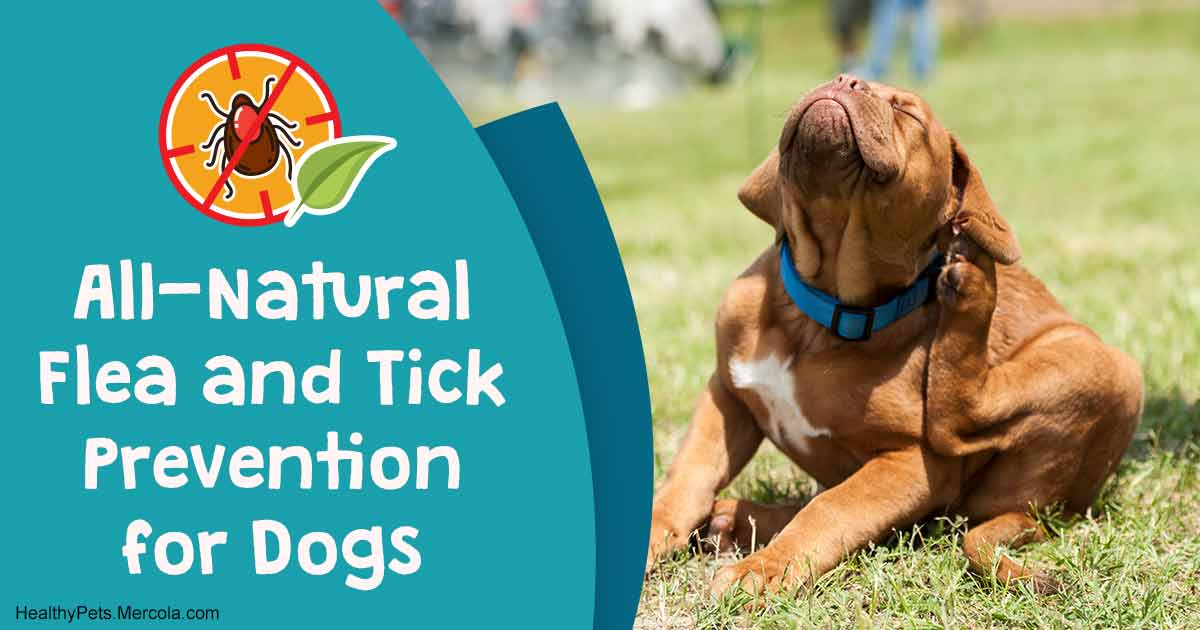When it comes to flea and tick protection, many veterinarians recommend chemical preventives as a solution (some even recommend them to pets year-round), but I don’t agree with the knee-jerk use of chemicals as a means of controlling nature, especially heading into the cold winter months in many parts of the world.
In deciding how to best protect your dog from fleas and ticks, you need to take into account when pest season begins and ends where you live, your pet’s individual risk (e.g., do you go for long walks in the woods or do a lot of hiking?), as well as the level of disease risk in your area.
Fleas 101
Fleas and ticks are very different types of pests. Fleas are related to ants and beetles, feed on blood, and their bites can lead to irritation and skin allergies.
Flea allergy dermatitis (FAD), which is actually sensitivity (allergy) to flea saliva, is a very common condition in dogs. It’s not the bite of the flea that causes most of the itching in dogs with FAD, it’s the saliva. The saliva causes irritation way out of proportion to the actual number of fleas on the pup.
Many dog parents assume if their pet isn’t infested with fleas, the itching can’t be caused by fleas. But if your dog has FAD, the saliva of just one or two fleas can make him miserably itchy and uncomfortable for many weeks, even after the fleas are gone. Fleas can also transmit tapeworms and can cause severe anemia, especially in young animals. However, fleas are primarily an annoyance, and if you live in an area where they thrive, it can seem like a constant battle to keep them under control.
Fleas flourish in temperatures between 65oF and 80oF with humidity in the 75% to 85% range. In some locations, flea season is year-round, but in others the types of fleas that bother pets and people aren’t considered a big problem.
It’s important to note that fleas aren’t typically attracted to healthy pets. They’re drawn to the weakest animals they can find, first, so one of the best defenses against flea infestations is to feed your dog a nutritionally balanced, species-appropriate fresh-food diet that will help keep his immune system functioning optimally. In addition to diet, it’s important to remove the environmental factors that can negatively impact your dog’s immune system, including:
Poor water quality — make sure to provide fluoride- and chlorine-free drinking water Too many vaccines — insist that your veterinarian runs titer tests instead of giving unnecessary vaccinations Toxic household chemical load — eliminate dog beds treated with PBDEs (flame retardants) and toxic household cleaners Yard chemicals — eliminate pesticides, herbicides and fertilizers around your home EMFs — provide your dog with a safe zone that’s free from toxic levels of electromagnetic fields from electrical devices in the home Tick-Borne Disease
Ticks are a type of arachnid related to mites, spiders and scorpions. They’re resilient, increasingly resistant to pesticides, and found throughout the U.S. Because ticks feed on many different animals (humans, dogs, cats, squirrels, mice, opossums, deer and more), and they feed for long periods of time, they’re quite good at acquiring and transmitting diseases, some of which can be life-threatening. Tick-borne diseases include:
Lyme disease
Cytauxzoonosis
Rocky Mountain Spotted Fever
Ehrlichiosis
Anaplasmosis
Hepatozoonosis
Babesiosis
Tularemia
Unfortunately, a single tick bite can expose your pet to multiple diseases, but exposure is not the same as infection. In many cases, your pet will be able to fight off tick-borne diseases with no treatment required. Most dogs’ immune systems do exactly what they’re supposed to do when a foreign bacterium enters their bodies — they mount an effective immune response.
The only way to know if a dog has effectively eliminated the bacteria (was exposed but not infected) or is currently infected is to follow up with a second test called a QC6 (Quantitative C6) that differentiates exposure from infection. Sadly, large numbers of dogs each year are unnecessarily treated with extensive antibiotic therapy because their veterinarians panic after seeing a positive exposure. Please don’t let your vet do this!
Up to 90% of dogs may have been exposed to tick-borne pathogens, but most are able to fight off infection on their own. In those that do not, quickly identifying the problem and creating an appropriate treatment plan is crucial. I recommend that my clients who live in tick-endemic areas or who have dogs who receive multiple tick bites each year have their pets tested every six months.
How do you make sure you’re catching possible tick-borne infections before they take hold? Ask your veterinarian to replace the standard heartworm test with a more comprehensive annual blood test that identifies several tick-borne potential pathogens long before dogs show symptoms.
The SNAP 4Dx Plus (from Idexx Labs) and the Accuplex4 tests (Antech Diagnostics) which screen for heartworm, Lyme disease and two strains each of ehrlichia and anaplasma should be screening tests for dogs in tick-endemic areas, in my opinion. Completing one of these simple blood tests every 6 to 12 months is the best way to:
Avoid unnecessary chemical preventive application Identify infections before chronic disease occurs Catch cases of dogs infected as a result of pesticide resistance (a growing problem)
I also recommend that pets living in tick-infested areas who test positive on the SNAP 4Dx Plus or the Accuplex4 also be screened for babesia exposure. The best way to detect exposure to this parasite is with a PCR (polymerase chain reaction) test that checks for the presence of babesia DNA.
Before You Reach for a Chemical Pest Preventive
I strongly discourage pet parents from automatically applying potentially toxic chemical agents to their dogs or around their home to repel or kill pests. The use of spot-on products may cause skin irritation, paralysis, seizures and even death if used improperly, and there are effective natural alternatives that are far safer.
In addition, ticks are growing resistant to chemical pesticides, which means your dog may still be exposed to tick-borne disease. I see many canine patients who’ve been given monthly doses of pesticides for years, yet turn up positive for tick-borne illness, including many dogs with Lyme disease that have been vaccinated against it.
Discontinue pesticides during the winter, if you live where there are freezing temperatures. If, however, you choose to use these chemicals, follow these precautions:
• Be very careful to follow dosing directions on the label, and if your pet is at the low end of a dosage range use the next lowest dosage. Be extremely cautious with small dogs, and do not under any circumstances apply dog product to your cat.
• Monitor your pet for adverse reactions after you apply a chemical product — especially when using one for the first time.
• Don’t depend exclusively on chemical treatments. Rotate natural preventives with chemicals, including diatomaceous earth, pet-friendly essential oil products and natural deterrent collars. An every-other-month rotation works well for many pet parents. In many parts of the country people find they can successfully control ticks with two doses a year: one in the spring and one in the late summer.
• Since your pet’s liver will be tasked with processing the chemicals that make it into the bloodstream, it can be very beneficial to give your dog a supplement to help detoxify her liver. I recommend milk thistle, which is a detox agent and also helps to actually regenerate liver cells. Another product I recommend is chlorella, a super green food that is a very powerful detox agent.
Work with your integrative veterinarian to determine how much to give your pet depending on her age, weight and the medications she’s taking. I recommend one dose daily for seven days following any chemical flea, tick or heartworm preventive application.
Safe, Non-toxic Alternatives to Chemicals
There are safe, non-toxic alternatives for flea and tick control for dogs, and they don’t have side effects, unlike virtually all forms of chemical pesticides. Alternatives I recommend include:
A safe, natural pest deterrent (see recipe below)
Cedar oil (specifically manufactured for pet health)
Natural, food-grade diatomaceous earth, topically
Fresh garlic (¼ teaspoon of freshly chopped garlic per 15 pounds of body weight)
Feed a nutritionally optimal, species-appropriate fresh food diet
Bathe and brush your pet regularly and perform frequent full-body inspections to check for parasite activity (if you spend a lot of time outdoors, it’s important to check your pet and yourself for ticks every night during tick season)
Use a flea and tick comb to naturally exfoliate your pet’s skin while removing or exposing pests (absolutely nothing takes the place of physically checking for ticks)
Make sure both your indoor and outdoor environments are unfriendly to pests
All-Natural Homemade Pest Deterrent for Dogs
You can make an all-natural pest deterrent for your dog very easily at home. It will help him avoid a good percentage of the pests he encounters, though not all of them. The recipe: mix 8 ounces of pure water with 4 ounces of organic, unfiltered apple cider vinegar and 10 drops of neem oil.
Neem oil is not an essential oil. It’s expelled or pressed oil and is effective because fleas and ticks are repelled by it. It’s also great for pets who are very sensitive to odors. Catnip oil can also be used as a pest deterrent, since it has been proven to be as effective as diethyltoluamide (DEET), the mosquito and tick spray humans use that has a number of toxic side effects.
If you want to add some extra punch to your dog’s pest deterrent recipe, go with five drops of lemon, lemongrass, eucalyptus or geranium oil. I use geranium oil quite a bit because I find it very effective. In fact, I use it in my Dr. Mercola natural flea and tick products. If you have a dog who comes in contact with ticks, adding the extra punch of one of the essential oils I listed can be very beneficial.
You can store your homemade pest deterrent in the fridge, which is what I do. Before your dog goes outside mist him with it, being careful to avoid the eyes. The active ingredients, especially the oils in the recipe, dissipate in about four hours, so you may need to reapply it several times throughout the day.
Sources:Bark, May 2019
Read more: healthypets.mercola.com






Recent Comments